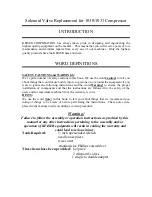
12 Decommissioning, Storage and Transport
12.1 De-commissioning
De-commissioning is necessary, for example, under the following circumstances:
■ The machine is (temporarily) not needed.
■ The machine is to be moved to another location.
■ The machine is to be scrapped.
Temporary de-commissioning
Precondition The machine can be started at regular intervals.
➤ Run the machine once a week under load for at least 30 minutes to ensure sufficient corrosion
protection.
Long-term de-commissioning
Precondition The machine must have run for at least 30 minutes before before long-term de-commissioning.
The power supply isolating device is switched off,
it has been locked off against unintentional reactivation and
the absence of voltage has been verified.
The machine is fully vented (depressurised).
Verify the absence of pressure using a suitable measuring device (pressure gauge).
1. Allow the machine to completely cool down.
2. Spray the valves and cylinder bore with Shell Ensis 20 preserving oil.
The oil does not need to be removed when re-commissioning.
3. Disconnect all air and electrical connections.
4. Spray all contacts and terminals with a preservative (e.g. Rivalto, W.S.X.).
12.2 Packing
A wooden crate is required for overland transport to protect the machine from mechanical damage.
Other measures must be taken for the transport of machines by sea or air. Please contact an au‐
thorized KAESER SERVICE technician for more information.
Material Desiccant
Plastic sheeting
Wooden crate
Precondition The machine is decommissioned.
Machine is dry and cooled down.
1. Wrap the machine fully in plastic sheeting.
2. Place sufficient desiccant (e.g. silica gel) inside the plastic sheeting.
3. Protect the machine in a wooden crate against mechanical damages.
12 Decommissioning, Storage and Transport
12.1 De-commissioning
82
Assembly and operating manual 1-stage piston compressor
EPC-G
No.: 9_5752 24 E











































